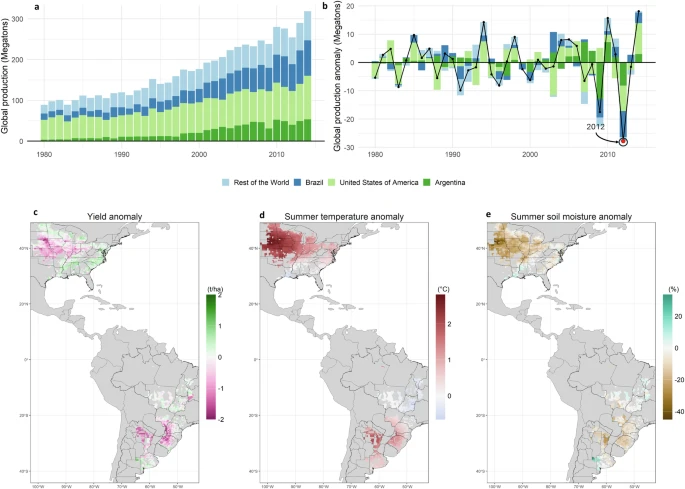PAPER: One-third of the global soybean production failure in 2012 is attributable to climate change
The paper is led by Raed Hamed (Department of Water and Climate Risk, Institute for Environmental Studies (IVM), Vrije Universiteit Amsterdam)
Reference: Hamed, R., Lesk, C., Shepherd, T.G. et al. One-third of the global soybean production failure in 2012 is attributable to climate change. Commun Earth Environ 6, 199 (2025). https://doi.org/10.1038/s43247-025-02171-x
Press release: https://vu.nl/en/news/2025/climate-change-threatens-global-soybean-production-urgent-action-needed
Climate change threatens global soybean production: urgent action needed
Source: https://vu.nl/en/news/2025/climate-change-threatens-global-soybean-production-urgent-action-needed
This highlights the increasing risk of global soybean harvest failures with warming, requiring urgent adaptation strategies, says the paper published in Communications earth and environment. The researchers studied how anthropogenic warming amplified the 2012 soybean crop failures in the United States, Brazil, and Argentina. These three regions together produce over 75% of the world’s soybeans, making them essential for global soybean supply.
Widespread crop failures
»We focused on the 2012 event because it was marked by synchronised hot and dry conditions across both the U.S. and South America, leading to widespread crop failures and record market prices. Understanding the role of climate change in such extreme events helps assess the costs of climate change today but also identifies future risks to global agricultural supply and commodity markets »’, explains Hamed.
Insights and blueprint
These results sharpen the understanding of how climate change can intensify large-scale crop failures. By examining how a specific weather pattern, like the one in 2012, might unfold at different levels of warming, the researchers highlight how rising temperatures can worsen soybean production shocks. The study also provides a blueprint for attributing impacts to climate change, which is crucial to quantify loss and damage from anthropogenic warming. It can also be broadened to include economic and social dimensions, showing how various policy or development paths might affect future risks.
Importance of climate risk assessments
On a practical level, the findings inform risk assessments and adaptation strategies by showing how climate change can amplify simultaneous “breadbasket failures” in key soybean-growing regions. Breadbaskets are regions that efficiently produce large quantities of cereals for the rest of the world. However, this concentration of production in a limited number of regions makes them vulnerable to joint harvest failures because of extreme weather. Climate risk assessments are thus important for policymakers, agribusinesses, and climate planners, as it underscores the need for more heat- and drought-tolerant soybean varieties, diversifying or relocating production, improving irrigation and farming methods, and reinforcing storage and trade systems.

From the paper | Figure 1 – Global and regional soybean production trends and 2012 anomalies.
Abstract: In 2012, soybean crops failed in the three largest producing regions due to spatially compounded hot and dry weather across North and South America. Here, we present different impact storylines of the 2012 event, calculated by combining a statistical crop model with climate model simulations of 2012 conditions under pre-industrial, present-day (+1 °C), and future (+2 °C) conditions. These simulations use the ECHAM6 climate model and maintain the same observed seasonally evolving atmospheric circulation. Our results demonstrate that anthropogenic warming strongly amplifies the impacts of such a large-scale circulation pattern on global soybean production. Although the drought intensity is similar under different warming levels, larger crop losses are driven not only by warmer temperatures but also by stronger heat-moisture interactions. We estimate that one-third of the global soybean production deficit in 2012 is attributable to anthropogenic climate change. Future warming (+2 °C above pre-industrial) would further exacerbate production deficits by one-half compared to present-day 2012 conditions. This highlights the increasing intensity of global soybean production shocks with warming, requiring urgent adaptation strategies.
